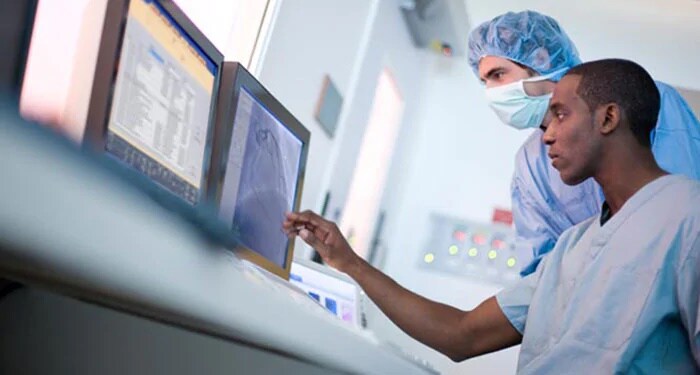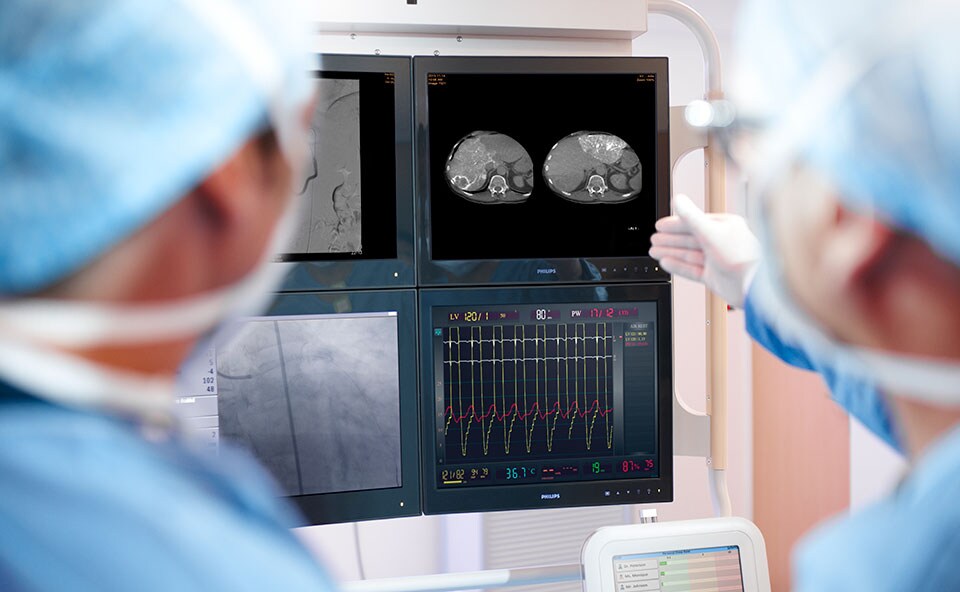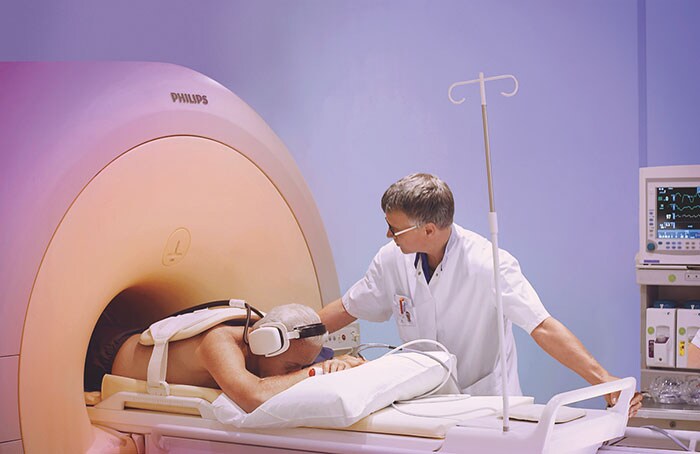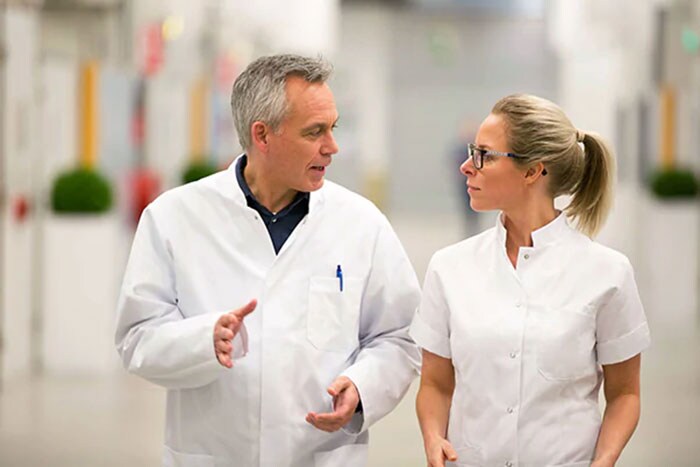News article
Bridging the gap between doctors and technology: how young scientists collaborate to innovate in oncology solutions
Fons van der Sommen (33) and Marco Janssen (34) are both young, ambitious scientists with the same drive: to further medical technology in oncology solutions in order to treat more people, better and faster. Fons is an assistant professor of research at the Eindhoven University of Technology (TU/e) and Marco works as a senior scientist oncology at Philips Research. Two different perspectives, one common goal. At World Cancer Day (February 4th), we reflect on this conversation, where Fons and Marco discuss their similarities, their motives and why collaborations between the business community, scientific institutes and healthcare institutions are so important.

Marco studied Biomedical Engineering because he wants to be a bridge between doctor and technique. "I talk to doctors and recognize trends in healthcare. I translate the questions and feedback from the doctor by thinking about the technology he needs to provide better care. I then transfer this to those who have to make the technology. We build prototypes and see if they contribute to improving the oncology care pathway. And if there is a solution, I translate the use of it back to the doctor." This career path was a conscious choice for Marco, because despite his inner drive to make people better, having direct contact with patients was not a good fit for him. "I would only take that home and I realized this when I worked as a scientist in the hospital.” Fons completely relates to Marco on this. "Ever since high school, I knew I really wanted to contribute to improving the lives of people. That is why I chose this direction. And this ambition only strengthened when my father died of cancer. It’s for that reason I also focus on oncology. But becoming a doctor myself, I thought that’d be too intense."
That is also true within Philips. Many people with different backgrounds, knowledge and skills work together and this diversity adds great value to the process of finding solutions.
Finding common ground
Fons actually studied Electrical Engineering, but he and Marco agree that the different studies do not make much of a difference to the common ground they share. "I see it as some kind of forest," says Fons. "Where the crowns of the trees are all connected to each other. I also prefer working with people from different backgrounds. Then you can complement and strengthen one another." Marco: “That is also true within Philips. Many people with different backgrounds, knowledge and skills work together and this diversity adds great value to the process of finding solutions." Fons, who received his PhD (cum laude), recently received a prize for his PhD thesis. Philips Research sponsored the prize and Hans Hofstraat (Vice President of Philips Research) personally awarded Fons with the prize—in recognition of the quality of his research on esophageal cancer and the practical application possibilities of his findings in practice. "Esophageal cancer is becoming more common and is even the fastest growing form of cancer in the Western world. Early detection is therefore important to increase the chances of healing," says Hans. Fons' work uses digital techniques to detect esophageal cancer earlier and better using advanced image processing. Hans: "He links excellent research to an important application and has bridged the gap between the TU/e and expert centers in the area of esophageal cancer, such as the Catharina Hospital in Eindhoven and the AMC in Amsterdam."

Sweet spot
Both men acknowledge that that’s not an easy task. Marco: "But this is where a nice collaboration with a university, clinical partners, and hospitals comes into play. Certain studies really start out more visionary within the academy and often in collaboration with clinical partners, for example with developing algorithms that can detect cancer. But before an industrial partner like Philips can convert this into a product, the technology must first be sufficiently 'mature' and have a certain level of accuracy. The cooperation between academia, hospital and industry is the ideal triangle for the development and validation of new technology. How do you offer that new technology? Do you rely on the algorithm, does it remain human work, or is it the combination? " Fons: "My vision is clear: there is a growing amount of information available for specialists due to the ever increasing capabilities of medical imaging equipment. Algorithms are there to reduce that to something that they can process. Algorithms never get tired and are not limited. No medical specialist can compete with that." Marco: "That also fits in perfectly with Philips' vision. Hans Hofstraat described this as follows: 'AI solutions support the care provider with the relief of routine work and help him to make a quick and optimal decision for a specific patient on the basis of all available relevant information.' Philips would rather not talk about artificial intelligence, but instead about adaptive intelligence technology, which takes both the user and the specific context into account."
That recognition from the business world is worth a lot, Fons and Marco agree. Fons: "In my work I am not only busy with research, but also with teaching and obtaining funding. The latter is a lot easier if the business sees value." Why did he win the award and leave his 'competitors' behind? “All nominees could have won; so many beautiful things are happening. I think I was just in a sweet spot. I am treating a social problem, and came up with something innovative and relevant. Incidentally, I am only a blip on the big picture radar of those working to improve healthcare. But I am helping to push the huge stone up the mountain."

Validation
"But when is the technology sufficiently 'matured' that it can actually be applied to new patients”, asks Marco. “When do we dare to use deep learning techniques for diagnostics? That is a very important question in the whole process." Fons: "You really need clinical partners to determine the requirements that such a system must meet. But you also need the business community, because they know what technical requirements are feasible for eventually implementing it in the clinic." Marco also sees a role for the business community there. "If we want the new technology to really come to the patient, sufficient investments must also be made to come to a proper validation. The biggest challenge in creating new solutions is not their development, but the successful implementation in the user environment."
Technology is the key to our future welfare and offers solutions for the bigger challenges in healthcare, more money for technical studies should not be seen as a cost item, but as an investment in the interests of everyone.
"The good news, however, is that we, as Philips, look to establish concrete partnerships,” Marco continues. “We do this for both the short and long term, for example by working in a triangle partnership with academia, hospital and industry on subsidized projects. Each of us is committed for the long term. Fons looks ahead to the future - as a company and together with hospitals – to ensure the necessary data can be generated and processed. As an industry, we can also pick out the low-hanging fruit from the research, with less critical claims, so that we can bring about improvements for the patient quicker, and which we can then build upon later. As a company, we really rely on their work. And every year that Fons continues his work, bears us more fruit tomorrow. This is how the academia-industry-hospital triangle gradually introduces new technology into patient care. These kinds of relationships offer so many opportunities, also in the long term." Both Marco and Fons believe that investing in training and talent is of great importance. Fons, who teaches at the TU/e University, finds it fantastic every time he excites a student. Marco: "We also need the people you train at Philips. Once again I quote from Hans Hofstraat: 'Technology is the key to our future prosperity and offers solutions for the major challenges in healthcare.' He also rightly calls for more money for technical studies. This should not be seen as a cost item, but as an investment in the interests of everyone."

Collaboration
Both Fons and Marco are very pleased with the new collaboration within the e/MTIC, which was formalized last year. This cooperation between TU Eindhoven, Philips, Máxima Medical Center, Catharina Hospital and the Kempenhaeghe Expertise Center should lead to more technical innovation in healthcare. Around a hundred TU/e PhD students are working within the consortium, together with a comparable number of experts and scientists from TU/e, the hospitals and Philips. Over the last 15 years, the parties have already worked bilaterally on projects with different focus areas. The partners expect that the intensive collaboration between clinic, science and industry will significantly shorten the development time from research to result for the patient.
It is precisely in such a partnership triangle between clinic, science and industry that everyone can take on their respective responsibilities and really get somewhere together.
Fons: "The pleasant thing about working with industry is that projects run smoothly when companies take the project leadership. As a university, we are generally less skilled at that. It is precisely in such a partnership triangle that everyone can take on their respective responsibilities and really get somewhere together. With partners within cycling distance of each other, that is even easier. If I have to consult with doctors at the Catharina hospital, I just cycle there." Marco adds: "We cannot work in isolation. Fortunately, the ecosystems have opened. In the past, industry would sometimes build a solution based on some new technology that had come out, and then look for a problem to solve with that solution. However, now we first start by talking about the existing problem and then about how to solve it efficiently. And this way of working is only possible if you collaborate with innovative partners and are open to each other's ideas."
Many of us know someone who has suffered from cancer. Perhaps you have even confronted cancer yourself. At Philips, we commemorate World Cancer Day alongside all of you, with a mission to collaborate and find innovative solutions to the many forms it takes.
